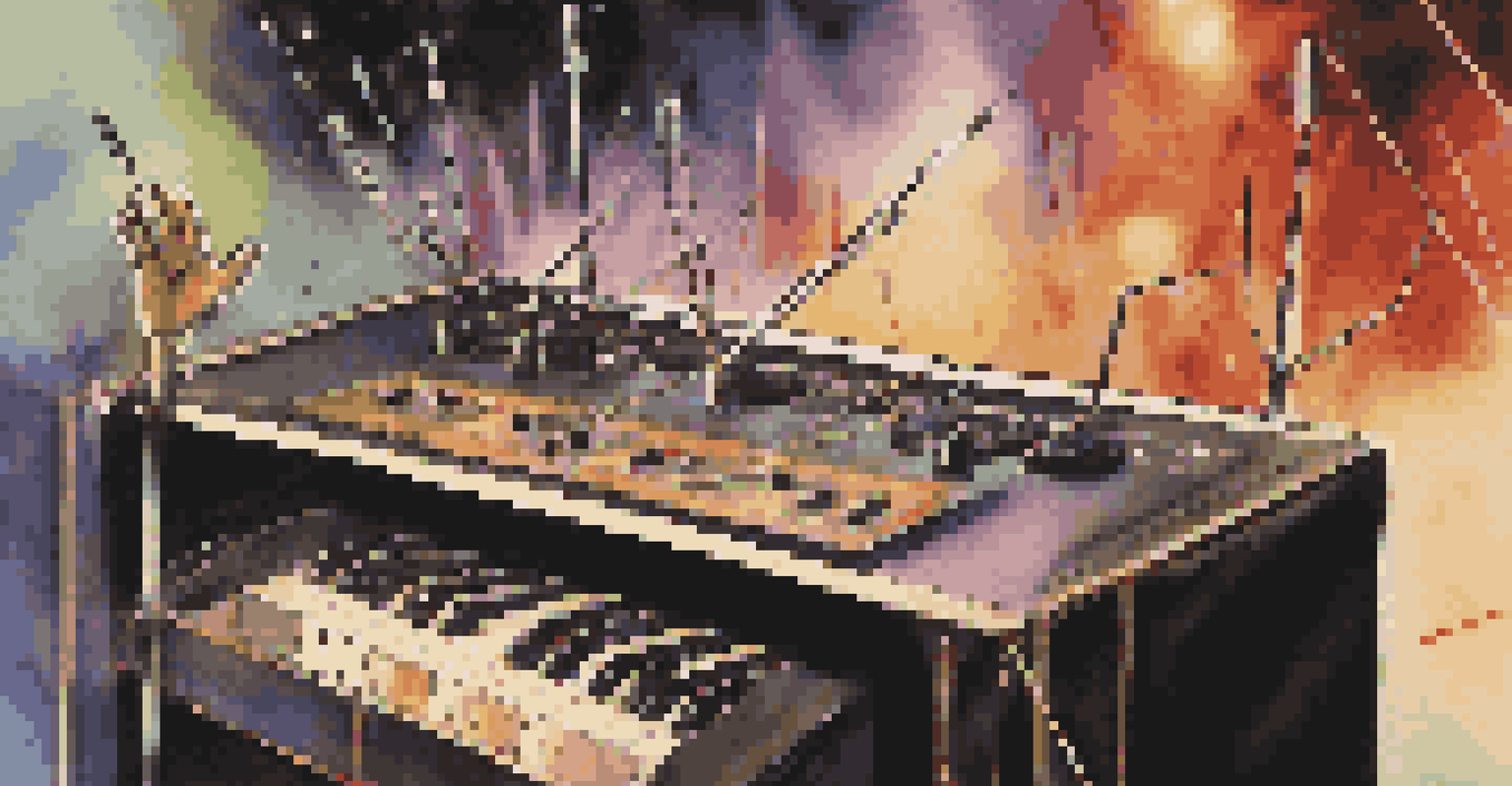The Theremin: An Electronic Instrument with a Unique Sound

What is a Theremin and How Does It Work?
The theremin is a unique electronic instrument known for its eerie, haunting sound. Unlike traditional instruments, it’s played without physical contact, which is part of what makes it so fascinating. Players manipulate two metal antennas that sense their hand movements, controlling pitch and volume, much like conducting an invisible orchestra.
The theremin is a remarkable instrument that allows us to express emotions without the constraints of physical contact.
This instrument works on the principle of capacitance, where the proximity of your hands affects the electric fields around the antennas. As you move your hand closer to one antenna, the pitch rises, while moving closer to the other controls the volume. This interaction creates a fluid and expressive sound that's unlike anything else.
Invented in the 1920s by Léon Theremin, the instrument's otherworldly tones quickly captured the imagination of musicians and composers alike. It's been featured in various genres, from classical to pop, and even in film soundtracks, adding a touch of the surreal to any piece.
A Brief History of the Theremin
The theremin's journey began in Russia, where Léon Theremin first demonstrated it in 1920. Initially intended as a tool for scientific research, its musical potential was quickly recognized, leading to its adoption by avant-garde musicians. Its unique sound caught the attention of composers, resulting in its use in early silent films and experimental music.

During the 1930s, the theremin gained popularity in the United States, where it was featured in radio broadcasts and performances. Notably, it was used in the iconic theme for the 1951 science fiction film 'The Day the Earth Stood Still', solidifying its association with futuristic sounds. This period marked the theremin as a symbol of technological innovation in music.
Eerie Sound of the Theremin
The theremin produces haunting sounds through hand movements that control pitch and volume without physical contact.
Despite ups and downs in its popularity, the theremin has experienced a renaissance in recent years. Contemporary musicians and bands are rediscovering its rich, expressive capabilities, proving that this instrument is far from obsolete. Today, it continues to inspire new generations of artists.
The Distinct Sound of the Theremin
The theremin's sound is often described as ethereal or ghostly, evoking a range of emotions. The lack of physical contact allows for fluid, gliding pitches that can mimic the human voice, making it a favorite for expressing longing or nostalgia. This quality has made it a staple in genres like ambient music and film scores.
The theremin has an ethereal sound that can transport listeners to otherworldly realms.
One of the most fascinating aspects of the theremin is its ability to create tension and release through pitch bending. By moving their hands slowly or quickly, players can build an emotional narrative that resonates deeply with listeners. This expressiveness is rare in most traditional instruments, providing a unique listening experience.
Moreover, the theremin's sound can be manipulated in various ways through effects pedals and synthesizers, expanding its sonic palette. Musicians often layer its haunting tones with other instruments, creating a rich, textured soundscape that captivates audiences. This versatility continues to attract innovative artists and composers.
Famous Theremin Players and Their Contributions
Throughout its history, several notable musicians have made significant contributions to the theremin's repertoire. Clara Rockmore, often referred to as the 'first lady of the theremin', was a virtuoso who showcased the instrument's musical capabilities in the mid-20th century. Her performances helped elevate the theremin from novelty to a respected instrument in classical music.
Another influential figure is Robert Moog, who, while known for his synthesizers, was also a passionate theremin player. He contributed to the instrument's design and helped popularize it in the 1960s, linking it to the burgeoning electronic music scene. His work paved the way for future generations of thereminists.
Rich History and Cultural Impact
Invented in the 1920s, the theremin has influenced various music genres and film soundtracks, solidifying its place in modern media.
In contemporary music, artists like Pamelia Kurstin and the band 'The Beach Boys' have kept the spirit of the theremin alive. Their innovative approaches and incorporation of the instrument into various genres highlight its enduring appeal. These musicians continue to inspire a new wave of interest in the theremin.
The Theremin in Film and Media
The theremin has made a significant mark in the world of film and television, often used to evoke mystery and suspense. Its unique sound has become synonymous with the sci-fi genre, appearing in classics such as 'The Day the Earth Stood Still' and 'Forbidden Planet'. These iconic uses helped establish the theremin as a staple in cinematic sound design.
Beyond science fiction, the theremin has also found its way into horror films, amplifying tension and eeriness. Its unsettling tones can elicit fear or unease, making it a perfect fit for chilling soundtracks. This versatility allows filmmakers to create a specific atmosphere that enhances the storytelling experience.
In addition to film, the theremin has made appearances in television shows, commercials, and even video games. Its distinctive sound can instantly transport audiences to otherworldly realms, further solidifying its place in modern media. As technology evolves, the theremin continues to adapt and inspire new creative expressions.
Learning to Play the Theremin
For those interested in exploring the theremin, it's essential to understand that playing it requires a different mindset compared to traditional instruments. The lack of physical touch means that players must develop a keen sense of spatial awareness and ear training. It's less about finger placement and more about mastering the art of movement.
Many resources are available to help aspiring thereminists get started, including online tutorials and instructional videos. Joining a community of theremin enthusiasts can also provide support and encouragement as you learn. Connecting with others who share your passion can enhance your experience and keep you motivated.
Future Innovations in Theremin
Technological advancements and renewed interest in vintage instruments are leading to new creative possibilities for the theremin.
Practice is key when learning the theremin, as developing muscle memory and control takes time. Don’t be discouraged by initial difficulties; with patience and determination, you can unlock the instrument's expressive potential. Soon enough, you'll be creating your own unique sounds and melodies.
The Future of the Theremin
As technology continues to advance, the theremin is evolving alongside it. Modern innovations have led to the development of digital theremins and software emulations, making the instrument more accessible to a wider audience. These advancements open up new possibilities for sound exploration and creativity.
Moreover, the resurgence of interest in vintage instruments has sparked a renewed fascination with the theremin. Musicians are increasingly seeking out its distinctive sound, leading to collaborations and experimental performances that push the boundaries of music. The theremin's unique capabilities ensure that it remains relevant in contemporary music scenes.

Looking ahead, the theremin is likely to inspire new genres and styles, as artists continue to experiment with its sound. As more people discover its capabilities, the potential for innovation is limitless. The theremin's legacy is far from over; it’s just beginning a new chapter in the world of music.